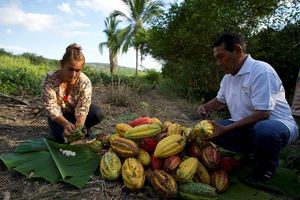Für IP-Professional
Sie befinden sich auf dem Portal für Fachleute, die im Bereich des Geistigen Eigentums arbeiten. Hier finden Sie Direktzugänge zu allen notwendigen Hilfsmitteln.


The Peruvian-Swiss Intellectual Property Project – PESIPRO, phase 2
PESIPRO-II aims to strengthen the use of selected IPRs in Peru in order to contribute to higher competitiveness, help to boost the added value of Peruvian products, and to have an overall positive impact on Peruvian economic development.
Project background and context

Peru and Switzerland share a long history of cooperation in many fields – such as trade, development, as well as diplomatic and cultural exchange. It therefore comes as no surprise that establishing cooperation in the field of intellectual property rights (IPRs) was equally in the interest of both partners. The first phase of the PESIPRO project was thus implemented between 2019 and 2021. PESIPRO-II builds on the successful implementation of PESIPRO phase I as well as other Swiss cooperation projects on IP, and intends to help tackle gaps and challenges in the Peruvian IP system so that users can fully benefit from its potential for innovation and socio-economic development. PESIPRO-II is being implemented under the Global Program on Intellectual Property Rights (GPIPR) between SECO and the IPI.
Peru’s integration into the international system of IPRs is well advanced. The country is a party to most treaties relevant to IPRs, including the Agreement on Trade-Related Aspects of Intellectual Property Rights (TRIPS Agreement) of the WTO and the Lisbon System on the protection of geographical indications of WIPO. The National Policy of Competitiveness includes the development of the country’s innovative capacity, in addition to the adoption and improvement of technology transfer. With these measures, the country aims to make its economy less dependent on exports of raw materials and accelerate its transition into an innovation-driven economy. The Peruvian authorities are aware that such a transition does not refer exclusively to technical or industrial innovation, but also essentially to “creative innovation”. Peru has a very dynamic international trade policy that manifests itself in several bilateral trade agreements.
Although Peru’s legal and institutional framework in the field of IPRs is well developed and the National Institute for the Defense of Competition and Protection of Intellectual Property (Indecopi) is very advanced in the management of all relevant IPRs, challenges still remain. These challenges mainly center around a continuous lack of awareness in the private sector and society as a whole of the importance of IPRs for protecting innovation, creativity, local products of high value and traditional knowledge, and for making economic use of it. Promoting the use of those types of IPRs that allow Peru to capitalize on its internal strengths is of particular interest to the Government of Peru and the overall goal of PESIPRO-II.
1 Why Peru? | 2 Objectives | 3 What we do | 4 Why IP | 5 Who benefits? | 6 Project Facts
Goals and objectives
Subsequently, the project focuses on supporting Indecopi in its efforts to achieve the following:
- Peruvian private sector and research institutes make better use of the patent and industrial design systems;
- Increased capacity of the Peruvian systems of denominations of origin (DO), geographical indications (GIs), and collective trademarks;
- Increased knowledge of copyright among the Peruvian creative industry and decision makers; and
- Increased awareness of indigenous people about the protection of traditional knowledge related to biological resources.
1 Why Peru? | 2 Objectives | 3 What we do | 4 Why IP | 5 Who benefits? | 6 Project Facts
Activities
In light of the advanced stage of Peru’s intellectual property system, the “filling-the-gap” approach of PESIPRO-I to address specific needs and requests adds the most value and appears to be the most appropriate strategy for achieving sustainable results and will be continued under PESIPRO-II. The project provides specialized advice and support in selected areas where Switzerland is able to offer strong expertise and achieve tangible results.
Within these thematic areas, the intervention strategy and its activities mainly consists of building technical capacity through training, workshops, and expert input, which are typically led by a national and an international consultant. These activities increase the capacity of Indecopi and other IP-related associations in delivering professional services. Furthermore, the project supports the concrete implementation of GI activities for two selected products – Café Villa Rica and Cacao Amazonas Perú. Capacity building in these two regions is expected to increase the income of local producers. The project thereby supports community development and product marketing activities.
1 Why Peru? | 2 Objectives | 3 What we do | 4 Why IP | 5 Who benefits? | 6 Project Facts
Alignment with Peru’s general development priorities
The Government of Peru, represented by Indecopi, proactively participates in and leads this project. In order to contribute to the economic as well as the social development of Peru, Indecopi underlines the importance for PESIPRO-II to provide support in the above-mentioned areas of high priority. Furthermore, for Indecopi, it is important that PESIPRO-II’s activities support (and strengthen) the process of creating and implementing a National IP Policy, and that these activities align with the National IP Strategy in the relevant sectors.
1 Why Peru? | 2 Objectives | 3 What we do | 4 Why IP | 5 Who benefits? | 6 Project Facts
Beneficiaries
The main beneficiary of this project is Indecopi. The Institute benefits through direct technical capacity building and through support for its strategies and programs. Indirect beneficiaries are mainly innovative SMEs and producers of GI products, as well as actors within the creative industries of the Peruvian private sector. Other economic actors as well as the wider Peruvian public benefit indirectly through improved IPR services and the increased quality and competitiveness of Peruvian goods and products.
1 Why Peru? | 2 Objectives | 3 What we do | 4 Why IP | 5 Who benefits? | 6 Project Facts
Quick project facts
Project duration
June 2022 – November 2026
Total budget
CHF/USD 1,500,000
Donor agency
Swiss State Secretariat for Economic Affairs – SECO
Implementing partners
Swiss Federal Institute of Intellectual Property – IPI;
National Institute for the Defence of Competition and Protection of Intellectual Property – Indecopi
Peru country context 2022
Population: 33 million
Area: 1,285,000 km2
GDP growth (⌀ 2017-2021): 2.1%
Income per capita (⌀ 2017-2021): USD 6,700
1 Why Peru? | 2 Objectives | 3 What we do | 4 Why IP | 5 Who benefits? | 6 Project Facts
Contact for more information
Reto Meili – Project Coordinator Peru
Swiss Federal Institute of Intellectual Property – IPI
reto.meili@ipi.ch | +41 31 377 72 71
Aktuelles
12.11.2025 | Patente, Recht und Politik
Geplantes Inkrafttreten der Patentrechtsrevision
...mehr lesen
30.10.2025 | Recht und Politik, Veranstaltung, Urheberrecht
Kreativität und KI: Wie das Urheberrecht dem Wandel begegnen kann
...mehr lesen
Agenda
30.10.2025 | Recht und Politik, Veranstaltung, Urheberrecht
Kreativität und KI: Wie das Urheberrecht dem Wandel begegnen kann
...mehr lesen
27.06.2025 | Patente, Weiterbildung, IGE.IPI
Unterstützung für die Patentanwältinnen von morgen
...mehr lesen

